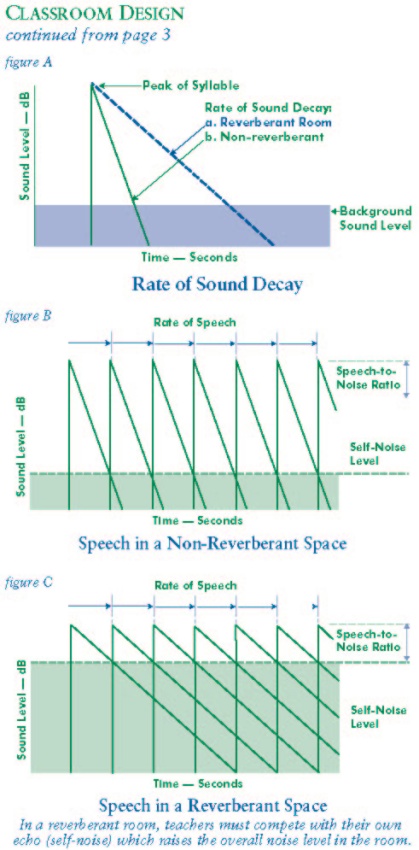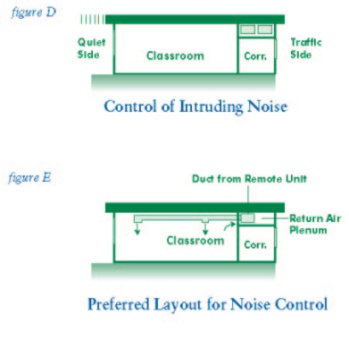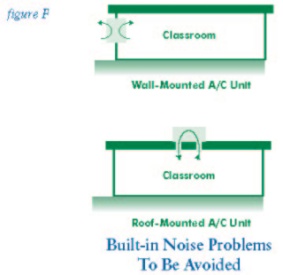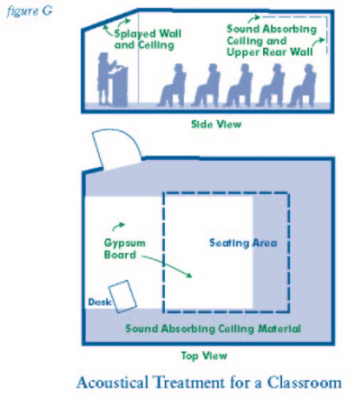Fall 2002
 .
.
(Adobe Acrobat PDF version)
FROM
THE DIRECTOR
On September 11,
2002, President Bush led the nation in a moment of silence. Even today,
the highest tribute we can pay is with quiet.
In this addition of the Quiet Zone,
we celebrate a victory for quiet: SONY corporation, the target of last
edition's letter-writing campaign, has stopped using the trademark "Disturb
the Peace" to sell incivility and dangerously loud car stereos.
Also in this edition, we initiate
another writing campaign, that with your help, we will also win. This
time the letter is positive, supporting newly adopted standards for
classroom noise from transportation, mechanical equipment, and
reverberation. The new standards are being challenged by some industry
and trade associations that don't want to build schools to standards
that ensure students can hear their teachers.
Please share this edition with
educators, return the postcard supporting quiet classrooms, and help our
nation and communities choose a future that is quiet.
Peace and Quiet,
Les Blomberg, Executive Director
|
The
Quiet Zone
A publication of
The Noise Pollution Clearinghouse
P.O. Box 1137
Montpelier, VT 05601
toll free (888) 200-8332
e-mail: npc@nonoise.org
website: http://www.nonoise.org
BOARD
Harriet Barlow, Director, Blue Mountain Center
Peter Barnes, Co-Founder, Working Assets
John Gilroy, Environmental Consultant
John Moyers, Executive Director, The Florence Fund
Alice Suter, Principal, Suter and Associates
ADVISORY BOARD
Mark Dowie, Writer and Environmental Activist
Bill McKibben, Writer and Environmental Activist
Stephanie Mills, Writer and Environmental Activist
David Morris, Director, Institute for Local Self-Reliance
STAFF
Les Blomberg, Executive Director
James Sharp, Communications Director/Webmaster
Garrett Schure, Project Director
Kristie Lyon, Office Manager
The Quiet Zone is published twice a year by the Noise
Pollution Clearinghouse, a non-profit organization dedicated to
creating more livable civil cities and more natural rural and
wilderness areas by reducing noise pollution at the source.
Editor:James Sharp
Layout and Design: Tim Newcomb |
Building a Quiet Classroom
Quieting a class
of students can be a challenge, but quieting a classroom built for
students is even more challenging when some of the companies that build
schools don't want to do it.
Classrooms are either quiet or noisy by
design. New standards just adopted by the American National Standards
Institute provide important guidance for schools in order to enhance
learning environments with what should not be a radical idea: that
students ought to be able to hear the teacher. Unfortunately, the Air-
Conditioning and Refrigeration Institute, the School Facilities
Manufacturers' Association, and the Modular Building Institute have
appealed the new standards or asked that they be withdrawn, claiming that
they are not in the public interest.
Help us spread the word that building
quiet, effective learning environments is in the public interest by
returning the letter between pages 4 and 5. And help get the accompanying
article on "Classroom Design for Good Hearing" on page 2, the
booklet Classroom Acoustics on our website, and the new ANSI standards
into the hands of your students' teachers, principal, and school board
(see page 4).
Now, we finally have a standard by
which to measure the acoustical performance of classrooms. Make sure your
child's education and your school property taxes are not being wasted in
the din of traffic noise, the roar of jet airplanes, or the rumble of
poorly designed heating and air-conditioning systems.
Classroom Design for Good Hearing
Ewart A. Wetherill
Classrooms may be noisy...
simply because of the way
they are constructed and finished.
It is a shocking fault, for the need to hear well
is basic in education.
McQuade, Schoolhouse, 1958
In the summer of
2002, the American National Standards Institute published Standard 12.60,
a totally new standard that provides acoustical performance criteria,
design requirements and design guidelines for new classrooms and
renovation of existing classrooms. The goal is to ensure a high degree of
speech intelligibility in learning spaces. In order to achieve this, the
noise level in an empty classroom should be kept to less than 35 decibels,
and reverberation or echoes controlled.
While the impetus for the standard
began initially as an effort to improve schools for children with impaired
hearing or other learning disabilities, children with normal hearing will
also benefit greatly from these standards.
The good news for architects and
builders is that compliance with the acoustical standards need not be
costly if they are incorporated early into the planning and design
process, although remodeling existing facilities could be expensive
depending on the actual situation. The requirements for good hearing were
first presented formally to the American Institute of Architects in 1898
and have been successfully applied to many schools. However, in the
absence of enforceable standards far too many schools have been built with
little or no concern for good hearing. Since acoustical problems are
created by the design they can just as easily be avoided by the design.
EXISTING CONDITIONS IN U.S. SCHOOLS
Elementary and secondary education, the
nation's largest public enterprise, is conducted in more than 80,000
schools in about 15,000 districts. America's public schools serve more
than 42 million students. In February 1995, the U.S. Government Accounting
Office (GAO) presented a report to the U.S. Senate on the results of a
survey of school officials across the country on the physical condition of
their facilities. The report comprised hard facts concluding that more
than $100 billion would be needed to restore all of the schools to good
condition. The most frequently mentioned of all the "unsatisfactory
environmental conditions" was "acoustics for noise control."
One outstanding example of acoustical
inadequacy can be found in the standards set by the Los Angeles Unified
School District, one of the largest in the country. These allow the use of
classroom ventilation/air conditioning units that are up to 20 decibels
noisier than would be permitted by Swedish standards. The inevitable
conclusion is that school children cannot hear much of what is said, while
teachers must shout to be heard at all. A second example that should be
familiar to many was the disastrous trend in the late 1960s to open-plan
schools. These created a situation in which some school children could
hear the teacher of an adjacent class more clearly than their own teacher.
Thus, a combination of outdated
facilities and unfortunate design or construction decisions leave us with
an inheritance that will be a burden for decades to come. This legacy of
past policies will consume a very significant part of the limited funds
that many communities seem currently willing to allot to school
construction or renovation; so skillful planning and site selection will
be essential to attain the new goals.
CHILDREN AT RISK
In December 1997, representatives of
eleven national groups joined the Acoustical Society of America in a
workshop on Eliminating Acoustical Barriers to Learning in Classrooms.
From this workshop has developed a coalition that worked actively to
further improved hearing conditions in schools. Leaders in the field of
audiology and a wide range of disciplines related to design and
construction of educational facilities presented the results of surveys
and research on the prevalence of hearing disorders and substandard
facilities, and their effects on hearing. The truly alarming statistics
clearly show the disadvantage resulting from poor hearing conditions for
both normal and hearingimpaired school children.
Studies of speech recognition confirm
that an adult listener hearing words in the context of a sentence can fill
in words or syllables that are not heard clearly, depending on the size of
the listener's vocabulary. Since children have smaller vocabularies, they
are less able to fill in the words not heard clearly. Similarly, someone
using English as a second language or someone who suffers from an
attention deficit disorder are at a significant disadvantage in a noisy
classroom. In addition, many children with usually normal hearing have
temporary hearing losses from illness. Otitis Media, a bacterial
infection of the middle ear that is the most frequently-occurring
childhood medical complaint, has more than doubled in the last decade.
Compounding the learning disadvantages
that confront children in noisy classrooms or with impaired hearing are
the constant discouragement and frustration that can inhibit the
motivation of even the most talented to learn and to excel.
The importance of clearly hearing the
teacher seems self-evident, but this has not been a design criteria of
many schools in the past.
REQUIREMENTS FOR GOOD HEARING
Two basic criteria must be satisfied to
meet the requirements for good hearing:
1. A quiet background (e.g. noise from intruding traffic, adjacent
classes, ventilation systems etc.)
2. Control of reverberation and self-noise
SPEECH TO NOISE RATIO
Speech in the classroom must be heard
over the prevailing background noise level, be it intruding noise from
traffic, adjacent classes, or a noisy ventilation system. A convenient and
easily measured descriptor is the Speech to Noise ratio (S/N). There is
general agreement that desired S/N ratios for speech recognition are:
Normal-hearing:
Adults: at least 6 decibels
Children: greater than for adults, at least 10 decibels
Hard-of-hearing listeners
Adults: at least 15 decibels,
Children: greater than for adults

By contrast, a survey of actual
classroom conditions taken between 1965 and 1968 indicated a Speech to
Noise ratio range from +5 decibels to -7 decibels. This information alone
adds support to the growing concern both for children's understanding and
for teachers' voice strain.
Reverberation (commonly known as an
echo) is defined as the persistence of sound in a room after the source
has stopped. In a reverberant space, successive syllables blend into a
continuous sound, through which it is necessary to distinguish the orderly
progression of speech. The level at which this sound persists is
determined by the size of the space, the speech level and the interior
finish materials. Reverberation time (the time it takes for a sound to die
off) is measured in seconds, with a low value-around 0.5 seconds or
less-being optimum for a classroom seating about 30 children.
Reverberation can be controlled by the use of readilyavailable
sound-absorbing wall and ceiling materials that comply with building code
requirements.
EFFECTS OF NOISE AND REVERBERATION ON
SPEECH RECOGNITION
Mean speech-recognition scores (the
percent of words correctly recognized) of adults with normal hearing for
various S/N ratios clearly demonstrate the connection between good
acoustics and effective hearing.
| S/N ratio |
Word Recognition |
+12 decibels (low-background noise)
+6 decibels
0 decibels (high-background noise) |
95.3%
80.7%
46.0% |
Mean speech-recognition scores (in
percent correct) of children for monosyllabic words with various
reverberation times (RT) show a similar correlation.
| RT - Seconds |
Normal Hearing |
Hearing Impaired |
0.0 (no echo)
0.4
1.2 (persistent echo) |
94.5 %
82.8%
76.5% |
87.5%
69.0%
61.8% |
The combined effects of poor Speech to
Noise and long reverberation time for children, which is the actual
situation encountered daily in many of the nation's schools, are
predictably a substantial handicap to entire classes. The following scores
are for monosyllabic words.
| Test Condition |
Normal Hearing |
Hearing Impaired |
| FOR REVERBERATION TIMES OF 0.0 SECONDS: |
+12 decibels
0 decibels |
89.2%
60.2% |
70.0%
39.0% |
| FOR REVERBERATION TIMES OF 1.2 SECONDS: |
+ 12 decibels
0 decibels |
68.8%
29.7% |
41.2%
11.2% |
The following conclusions can be drawn
from these test results and from corroborating evidence compiled from
other test situations.
1. Understanding of children with normal hearing can be seriously
affected by a combination of excessive background noise and reverberation.
2. Hearing impaired children are always at a disadvantage compared to
those with normal hearing but the difference can be minimized by
acoustical controls.
3. Comprehension levels for multisyllabic and unfamiliar words can be
expected to be worse than indicated by monosyllabic testing.
4. Decrease in intelligibility with distance from the teacher can be
minimized by acoustical treatment and shaping of the space.
EFFECT ON TEACHERS
In addition to children's hearing
concerns, the effect of trying to compete with an acoustically-difficult
environment creates a problem of severe strain on the vocal chords for
many teachers. While not as well-known or studied as the listener's
ability to understand, voice strain is belatedly being recognized as a
serious and potentially incapacitating problem for teachers. However,
effective acoustical treatment of a classroom can create significant
benefits here also.
EXAMPLES OF EFFECTIVE CLASSROOM DESIGN

Designers and builders can improve
hearing conditions in schools by incorporating the basic principles of
acoustics into classroom design. For every new and remodeled school, the
control of unwanted sounds and enhancement of wanted sounds, without the
complications inherent in general amplification, should be placed high on
the list of design goals. For new classrooms accommodating from 30 to 40
children these requirements should not add anything to the cost of either
design or construction. However, correction of acoustical deficiencies in
existing facilities could be costly, depending on the particular
situation.
At least the following considerations
must be addressed (see appended sketches):
Control of unwanted sounds

- locate schools away from highways, rail tracks, and flight paths
- minimize noise intrusion from outdoors (figure D)
- minimize interference between classrooms
- design quiet ventilation system (figures E and F)
Enhancement of wanted sounds
- control excessive reverberation by sound absorption
- minimize echoes from distant surfaces (such as the back wall)
- use hard materials for useful sound reflections (such as on surfaces
beside and above the teacher)

Figure G shows a suitable
acoustical treatment for a "traditional" classroom
configuration. For other desired class uses, redistribution of the
required sound absorption may be appropriate. The booklet Classroom
Acoustics, available at NPC's website, www.nonoise.org/quietnet/qc/,
and the ANSI Standard S12.60 are of help when working with teachers and
administrators.
What you can do to make classrooms quieter
and better learning environments
| Extra
Credit |
Purchase the ANSI standard and the booklet "Classroom
Acoustics" for your children's school |
- $40 for standard and booklet from the Noise Pollution Clearinghouse,
(these are being resold at cost by NPC and purchases are not tax
deductible
- OR &35 for an electronic PDF version of the standard available at
http://asastore.org; the booklet can be downloaded for free from our
website
http://www.nonoise.org/quietnet/qc
| Extra
Credit |
Get a friend to send the second postcard to ANSI |
| A+ |
Get a teacher to send a letter on his or her own
stationery to:
Ms. Ann Caldas
Board of Standards Review
American National Standards Institute
25 West 43rd Street, 4th Floor, NY, NY 10036
Tell the Board of Standards Review that the classroom acoustics
standards is in the public interest. See below for a list of points
teachers should cover. |
| A |
Send a letter on your own stationery to:
Ms. Ann Caldas
Board of Standards Review
American National Standards Institute
25 West 43rd Street, 4th Floor, NY, NY 10036
Tell the Board of Standards Review that the classroom acoustics
standards is in the public interest. See below for a list of points
teachers should cover. |
| A- |
Send the postcard to ANSI with about 500 to
1,000 others! |
| Need to do
some homework on classroom noise? Go to the Classroom Acoustics library
at http://www.nonoise.org/quietnet/qc/ |
Writing Your Own Letter?
Here's What You Need to Know
The noisy school industry wants people to think that creating quiet
classrooms is:
1. Radical and unrealistic
2. Too costly
3. Not in the "public interest"
HERE'S WHAT YOU SHOULD SAY:
The 35 decibel level is recommended by the World Health
Organization.
| To be able to hear and understand spoken messages
in class rooms, the noise level should not exceed 35 dB LAeq during
teaching sessions. For hearing impaired children, a still lower sound
pressure level may be needed. The reverberation time in the class room
should be about 0.6 seconds, and preferably lower for hearing impaired
children. |
| |
World Health Organization, 1995 |
We can't afford not to build good learning environments when we
build schools. For each noisy classroom, hundreds of students over the
next 20 to 50 years will miss what their teacher is saying. Public school
tax dollars will be wasted and students will be held back in their
learning.
| In most classrooms the dominant background
noise source, and the main obstacle to achieving the recommended
background noise level is the heating, ventilating and air
conditioning (HVAC) system. Individual experts, members of the
American Society for Heating Refrigerating and Air Conditioning
Engineers (ASHRAE), have estimated HVAC costs to be 10% of the total
costs to build classrooms with approximately 45 dB(A) background noise
levels. These experts also estimate that upgraded HVAC systems could
achieve 35 dB(A) background noise levels for 14.5% of total costs. Thus,
the incremental cost to achieve the ASA acoustic performance goal for
HVAC background noise is 4.5%, or $4.56 per square foot. This estimate
is based on the median costs per square foot for new classroom
construction in high schools, which typically have the highest
construction costs per square foot. The median incremental cost per high
school classroom is approximately $5000-an annual cost of about $250 per
classroom, or $8.40 per student in a 30-student classroom over the
estimated 20-year lifetime of the materials. When the ceiling tile and
HVAC costs are combined, the total annual cost per student of achieving
the recommended acoustic goals is slightly over $11, a small price to
pay for the removal of acoustic barriers in the classroom. |
|
Acoustical Society of America, 1998 |
Effective public education is in the public interest. The
National Center for Educational Statistics reports that 18% of schools
suffer from poor acoustics or noise control. In these classrooms, students
listen to jet planes, trucks, or the drone of an air conditioner or fan
instead of the teacher. The cost to retrofit and fix problems after they
are built is orders of magnitude greater than the cost of good original
design. We are already saddled with these schools, and it will be years
(and thousands of students) before they are fixed. We don't need to build
more bad schools. 18% is already too high. We should not build any more
schools that fail to meet reasonable acoustical standards.
| "When it comes to the education of our
children... failure is not an option." |
|
President George W. Bush |
"The school was
established to promote learning, which is acquired largely by word of mouth
and listening. Therefore, acoustics is one of the most important physical
properties that determine how well the school building can serve its primary
function. Thus the exclusion of noise and the reduction of reverberation are
indispensable in adapting classrooms to the function of oral instruction"
Vern Knudsen and Cyril Harris, Acoustical
Designing in Architecture (1950)

In a small victory for Peace and Quiet, and a
larger one for civility, SONY corporation has stopped using its
trademarked slogan "Disturb the Peace" to sell its dangerously
loud car stereos, amplifiers, and speakers. In addition, a number of
communities have adopted boom car standards.
Thank you very much for your
overwhelming help in this campaign. Your letters to SONY chairman and CEO
Howard Stringer helped reign in corporate misbehavior.
We still have a long way to go. Boom
cars still shake windows and walls, wake neighbors, cause car accidents,
and injure the hearing of car occupants, but one less corporate giant is
encouraging bullies to break the law and disturb the peace.
Leave a Legacy of Peace and Quiet
Many of the values that we hold dear, such as
peace and quiet, remain important to our friends, families and communities
long after we are no longer here ourselves. Including the Noise Pollution
Clearinghouse in your will is one way to help sustain the quality of life
you believe in for your community and loved ones.
Leaving a Legacy of Peace and Quiet is
easy through a simple bequest. You should consult your lawyer or estate
planner, but a basic bequest might read "I give and bequeath to Noise
Pollution Clearinghouse (Montpelier, Vermont) the sum of $xxx."
Bequests can also be made as a percentage of your total estate, or the
remainder of your estate after all other bequests are fulfilled. Please
contact us if you have decided to, or are thinking about, including NPC in
your will.
What NPC's Doing Next Year
Starting next year, NPC is undertaking at least three major projects
that will help urban cities, suburban neighborhoods, and rural and
wilderness areas. Next year look for our efforts to quiet:
1. Urban cities: Motorcycle and Truck Noise Regulation-the
laws are on the books but poorly enforced, and better regulations exist.
2. Suburban neighborhoods: Quiet Lawns- a Consumer
Reports-like look at lawn equipment noise.
3. Rural and wilderness areas: Quiet Lakes-a series of
projects aimed at jet skis, air boats, cigarette boats, state boating
regulations (currently, no state's boat noise regulations are quieter than
the federal standards for trucks, which also are too loud-see above), and
creating quiet times, days, and lakes.
 .
.




